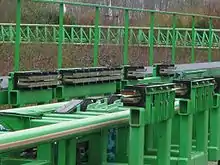Goliath (Walibi Holland)
Goliath is a steel roller coaster located at the Walibi Holland theme park in Biddinghuizen, Dronten in the Netherlands. It is described as "the fastest, highest and longest coaster in the Benelux". It was mainland Europe's second Intamin "Mini Hyper Rollercoaster", so named as the ride is styled on the larger (generally over 61 metres (200 ft)) ride, but with a lower maximum height of 47 metres (154 ft). The train travels at speeds of up to 107 kilometres per hour (66 mph) along 1,214 metres (3,983 ft) of track.[1]
| Goliath | |
|---|---|
 | |
| Walibi Holland | |
| Location | Walibi Holland |
| Park section | Speed Zone |
| Coordinates | 52°26′19″N 5°45′41″E |
| Status | Operating |
| Opening date | March 29, 2002 |
| General statistics | |
| Type | Steel |
| Manufacturer | Intamin |
| Designer | Ing.-Büro Stengel GmbH |
| Lift/launch system | Cable lift hill |
| Height | 47.17 m (154.8 ft) |
| Drop | 46.31 m (151.9 ft) |
| Length | 1,214 m (3,983 ft) |
| Speed | 106 km/h (66 mph) |
| Inversions | 0 |
| Duration | 1:32 |
| Max vertical angle | 70° |
| Height restriction | 140 cm (4 ft 7 in) |
| Trains | 2 trains with 8 cars. Riders are arranged 2 across in 2 rows for a total of 32 riders per train. |
| Goliath at RCDB Pictures of Goliath at RCDB | |
Ride information
The roller coaster is another collaboration of Swiss manufacturer Intamin and German engineer Werner Stengel. It employs similar lift hill technology as Expedition GeForce, utilizing a cable lift. The ride premiered in the 2002 season.[1]
Ride layout
After climbing out of the station, the train is released from the catch car at the top of the lift hill and accelerates down the 152-foot (46 m) first drop and runs over a large hill. After dropping for the second time, it ascends a hill called a Stengel Dive, the top being overbanked to around 100° to the right, before dropping down into a 270° downward helix. After medium-sized curved hill, it negotiates a 380° upwards helix and a bend to take the track parallel to the lift hill. Before entering the brake run, riders experience considerable air-time on three bunny hops.[1][2]
Trains
Goliath has two trains with eight cars each. Each car seats two across in two rows. The trains are made of steel and have stadium-style seating. Restraints are hydraulic lap-bars.[1]
Gallery
 Overview of the roller coaster.
Overview of the roller coaster. A close up of the braking system.
A close up of the braking system.
References
- Marden, Duane. "Goliath (Walibi Holland)". Roller Coaster DataBase.
- Alvey, Robb. "Goliath Roller Coaster Front Seat POV Walibi World". Theme Park Review. YouTube. Retrieved 25 July 2010.
External links
- Walibi Holland website
- Attraction webpage (English Translation)